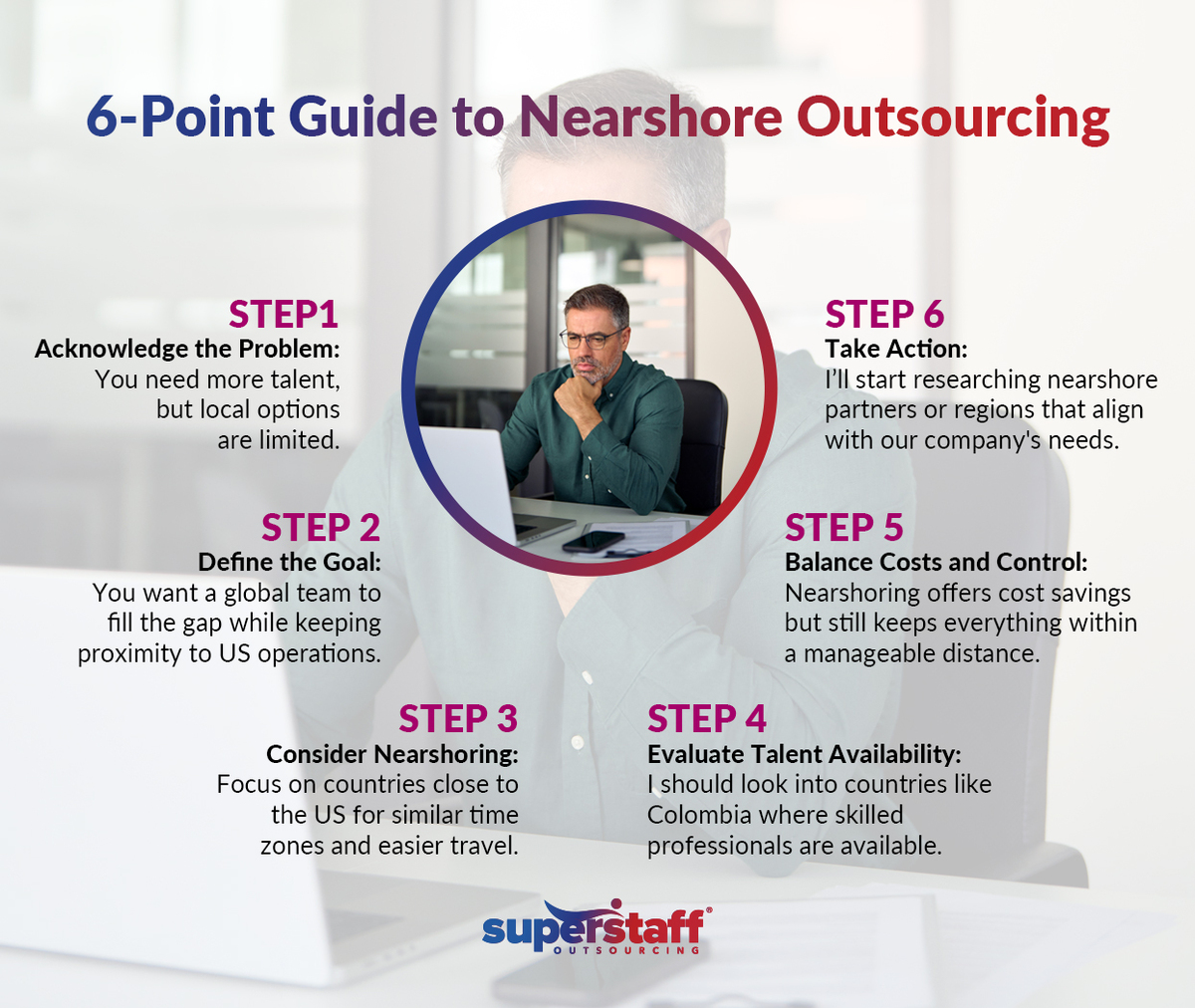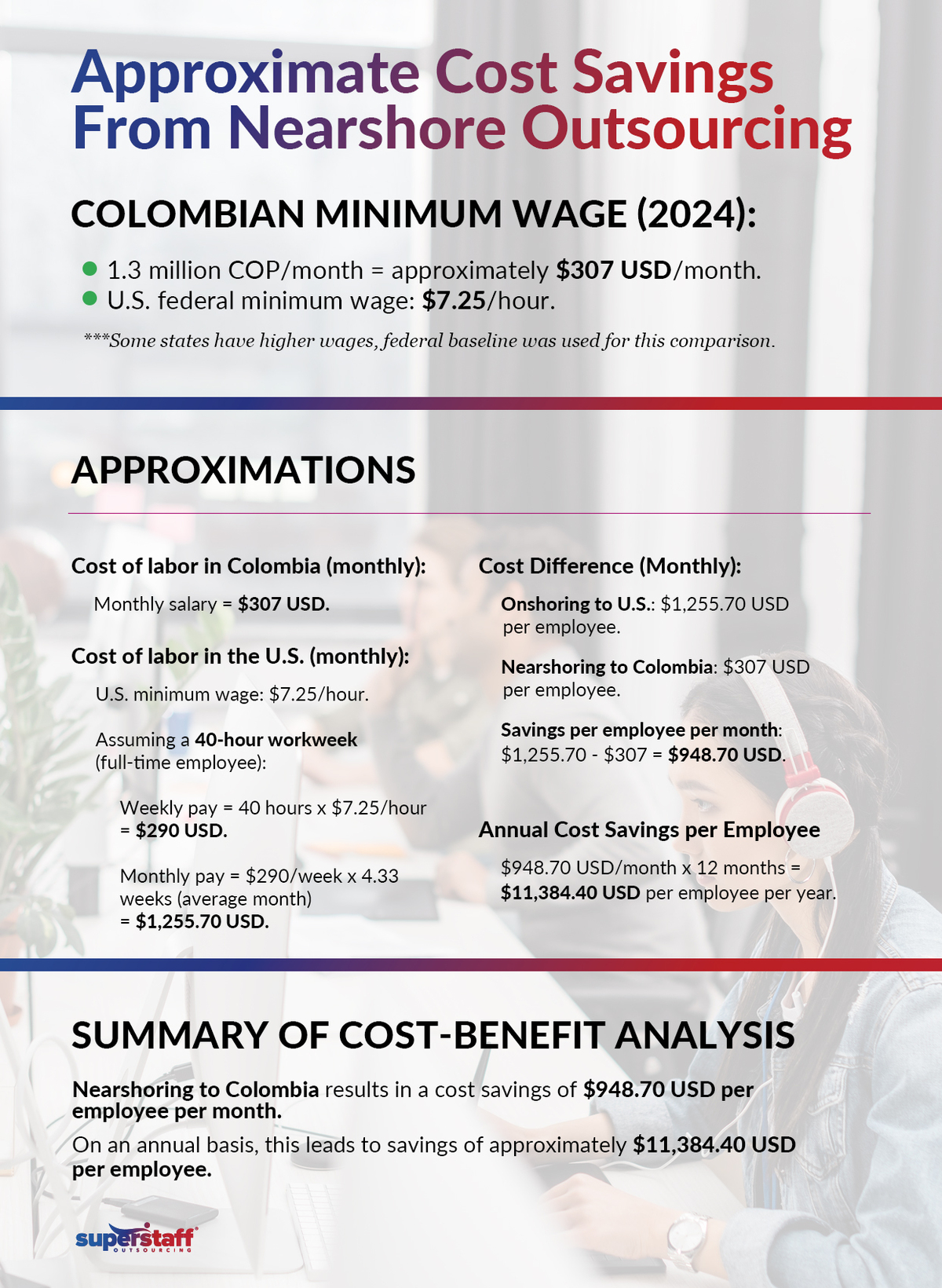
As a business leader, you’re constantly seeking strategies that drive efficiency while keeping your business close to home. Enter nearshoring — a game-changing approach for companies facing talent shortages or rising operational costs.
With nearshore outsourcing, you can delegate critical business functions to countries geographically closer, ensuring seamless collaboration, real-time communication, and cultural alignment.
For U.S. businesses, nearshoring means tapping into the skilled workforce of Latin American nations like Colombia. Beyond proximity, it offers significant cost savings and operational efficiency through lower labor expenses without sacrificing quality or oversight.
In this guide, we’ll explain everything you need to know to implement nearshoring successfully. From identifying your needs to scaling your operations, this is your step-by-step blueprint for making nearshoring work for you.

Step 1: Evaluating Your Business Needs
The first step in the nearshoring process involves a critical question: What aspects of your business should be outsourced? Accurately identifying and evaluating these needs is essential to delegating the right tasks while allowing your core operations to continue smoothly and without disruption.
Assess Your Business Objectives
Start by defining your company’s goals and objectives. What are you aiming to achieve through nearshore outsourcing? Consider the following key benefits:
- Cost Savings and Efficiency – Outsourcing non-core functions can significantly reduce costs. Instead of spending on recruitment, training, and resources for tasks outside your primary focus, nearshoring saves up to 70% on operational expenses.
- Access to Specialized Skills and Expertise – Functions such as IT support, customer service, and back-office operations often require specialized skills that may be challenging for your in-house team to manage. By nearshoring these tasks, you can tap into a pool of experts with years of experience, allowing your internal team to focus on core operations.
- Increased Operational Flexibility and Scalability – Nearshoring offers the flexibility to scale your operations based on demand. During seasonal peaks, such as customer service surges, you can efficiently delegate tasks to your BPO provider, ensuring your business remains agile and responsive to changing needs.
- Improved Time-to-Market – By outsourcing non-core tasks, your company can focus more on critical business functions, leading to faster time-to-market for products and services. This enhanced focus allows for more efficient marketing and product development, keeping your business competitive while your BPO provider handles essential support functions.
Evaluating and aligning your business needs with your objectives ensures that your nearshoring strategy maximizes efficiency, expertise, and flexibility for long-term success.
Identify Your Core and Non-Core Business Functions
Identifying your core and non-core functions is critical in determining your outsourcing needs. Ask yourself: What is your business known for, and what activities directly drive your primary revenue? Conversely, what tasks lie outside your expertise but are essential for day-to-day operations? Answering these questions will help you pinpoint which areas to consider for outsourcing.
Core functions are your company’s primary source of income, focusing on products or services that define your business. Non-core functions, while not directly tied to your revenue stream, are necessary to support your core operations. Examples include customer service, IT support, accounting, and data management.
Performing a Cost-Benefit Analysis
Outsourcing requires thoughtful resource allocation, making a cost-benefit analysis essential. Start by comparing the expenses associated with handling tasks in-house versus outsourcing them. According to Forbes, your analysis should consider five factors: direct and indirect costs, intangible costs, opportunity costs, and risks.
Direct and indirect costs include employee salaries, office space, and operational maintenance. For outsourcing, you’ll need to account for expenses related to your nearshoring provider. Intangible costs may include contract setup fees, training, or additional unexpected expenditures. Weighing these factors will provide a clearer understanding of the financial impact and strategic advantages of nearshoring.
After thoroughly evaluating your business needs, the next step is selecting the right nearshoring location. Let’s explore that decision in more detail.
Step 2: Choosing the Right Nearshoring Location
Selecting the ideal nearshoring location is critical to building a successful outsourcing partnership. When making this decision, it is essential to evaluate talent availability, time zone alignment, cultural compatibility, and regulatory obligations. Ensuring these factors align with your outsourcing needs is key to establishing a productive and seamless relationship.
Research Regions With Strong Industry-Specific Talent Pools
The right nearshoring provider offers geographic proximity, fosters collaboration, and, most importantly, provides access to the talent pool that matches your business needs. Outsourcing to regions with industry-specific expertise ensures your non-core functions are handled efficiently.
For example, Colombia is an emerging nearshoring hub in Latin America known for its strong labor market. Colombia’s labor participation rate increased to 64.2% in July 2024, reflecting a robust and growing workforce. This makes Colombia an attractive option for businesses seeking specialized talent.
Consider Cultural and Language Fit to Minimize Miscommunication
Cultural alignment is essential to reducing miscommunication and fostering effective collaboration. Outsourcing to a nearshore partner like Colombia offers significant advantages in this regard. English is widely spoken as the second language, and the cultural similarities between Latin America and the U.S. make Colombia an excellent choice for minimizing cultural and language barriers. This compatibility enhances communication and increases operational efficiency.
Check Legal and Regulatory Compliance: Labor Laws and Data Security
Compliance with labor and data security laws is paramount when selecting a nearshoring partner. In Colombia, labor laws mandate a 48-hour workweek, which will shift to 44 hours starting July 2025. It’s also important to consider minimum wage standards; as of 2024, the minimum wage in Colombia is 1.3 million Colombian pesos per month, equivalent to approximately $307 U.S. dollars.
In addition to labor laws, your BPO partner must comply with data security regulations. Colombia’s Law 1581 of 2012 protects personal data, ensuring that your partner handles sensitive information securely and responsibly. Compliance with these laws reinforces trust and credibility, crucial to a successful outsourcing relationship.
By carefully considering these factors, you can choose a nearshoring location that meets your business requirements and sets the stage for a successful partnership.
Examine the Region’s Infrastructure and Ease of Doing Business
When choosing a nearshore partner, one key factor is the region’s infrastructure and ease of doing business. According to the International Trade Administration, Colombia boasts Latin America’s fourth-largest economy, offering significant business advantages. Medellin, in particular, has earned a reputation for its infrastructure, driving economic growth and quality-of-life improvements. These advancements make Medellin an attractive investor hub and an ideal location for outsourcing operations.
With infrastructure and business environment in mind, the next step is identifying a reliable nearshore partner. Let’s explore the details of this crucial selection process.
Step 3: Search for a Reliable Nearshore Partner
Finding a trustworthy partner is critical to the success of your nearshore outsourcing strategy. The capabilities, culture, and credibility of your BPO provider will directly impact your operational outcomes.
Perform Your Due Diligence
Thorough research is essential when evaluating potential nearshore partners. Start by reviewing their LinkedIn profiles and company websites. Social media platforms can provide valuable insights into a company’s reputation and industry presence. Once you’ve reviewed these platforms, look for testimonials, case studies, and examples of successful business partnerships to assess their credibility. These resources offer a deeper understanding of how their services can benefit your business.
Request Proposals from Shortlisted Service Providers
Issuing a request for proposals (RFP) is essential in evaluating outsourcing providers. An RFP allows you to comprehensively view each candidate’s services, expertise, and pricing structure. In previous articles, we outlined an RFP template for customer service outsourcing. Key elements to include in your RFP are a detailed description of the services required, challenges your business faces, specific goals for the outsourcing partnership, and any financial considerations, such as billing or salary expectations.
Conduct Interviews and On-Site Visits to Verify Capabilities
Nearshoring offers a unique advantage through geographic proximity, enabling easier on-site visits and in-person interactions. Scheduling visits and interviews allows you to firsthand evaluate your partner’s capabilities and better understand how their operations can enhance your own. These interactions also help assess whether the nearshore partner aligns with your company’s culture, ensuring smoother collaboration and more efficient operations.
Once you’ve completed this vital step, it’s time to formalize the partnership. Next, we’ll discuss contract negotiations, service level agreements (SLAs), and how to establish a solid foundation for your nearshoring relationship.
Step 4: Negotiate Contracts and Service-Level Agreements (SLAs)
After selecting your nearshoring partner, the next step is clearly defining expectations and deliverables through well-structured contracts and SLAs. This process is crucial for protecting your business and your partner, ensuring that performance standards, responsibilities, and outcomes are clearly outlined.
Outline Deliverables, SLAs, and KPIs
An SLA is a vital document that formalizes your collaboration, outlining your nearshoring provider’s deliverables, timelines, and performance expectations. It ensures that your outsourcing objectives are met while setting clear expectations for timely and high-quality delivery. SLAs typically include detailed descriptions of the provider’s responsibilities, deadlines for critical deliverables, and measurable performance metrics such as key performance indicators (KPIs). Both parties must sign this agreement to establish a formal and accountable outsourcing process.
Setting Performance Metrics
Performance metrics are essential for monitoring and evaluating your nearshoring partner’s output. They help ensure that the provider meets the quality standards and business objectives set in the SLA. Establishing realistic and achievable metrics is essential to fostering a productive and efficient partnership.
Key performance metrics may include uptime (service availability), response times (how quickly your provider addresses customer needs), and service levels (a measure of how many agreed-upon goals are met). These KPIs provide a framework for continuous performance assessment.
Discuss Pricing Models and Payment Terms
Aligning pricing models and payment terms is critical to ensuring financial transparency and predictability. One effective way to structure this discussion is through a request for quotes (RFQ), which allows you to obtain and compare pricing details from your provider. This document helps clarify costs, making it easier to budget and plan while ensuring your nearshoring provider’s pricing aligns with your financial expectations.
Ensure Data Security Compliance
Data security is paramount when outsourcing. Your nearshoring partner will handle sensitive information such as personal data and financial records, making compliance with data protection laws essential. Regional regulations, such as Europe’s General Data Protection Regulation (GDPR), provide a framework for securing personal information. If your business operates within or interacts with regions subject to GDPR, ensuring your nearshoring partner complies with these regulations is vital. Include clear clauses on cybersecurity and confidentiality in your contracts to safeguard sensitive data.
With contracts and SLAs formalized, your next step is to seamlessly integrate your nearshoring team into your business operations, ensuring a smooth transition and efficient workflow.
Step 5: Onboarding Your Nearshore Team
A successful onboarding process is essential for fostering a productive outsourcing partnership, establishing effective communication channels, and ensuring alignment between your business functions and your nearshore team.
Create a Comprehensive Onboarding Plan
According to Glassdoor, a smooth onboarding process can increase employee retention by 82% and boost productivity by 70%. A well-structured onboarding plan builds trust, enhances efficiency, and facilitates a seamless transition for your nearshore team into your business. Your plan should cover the operational tools your business uses, company policies, access protocols for company assets, and a detailed orientation of what to expect in the first few weeks of working with your team.
Define Communication Protocols to Ensure Alignment
Clear communication is critical to maintaining alignment between your nearshore team and your business objectives. Studies show that effective communication increases employee productivity by 72% and confidence by 60%. Establishing strong communication protocols ensures your nearshore team remains informed and engaged, especially during peak business periods or organizational changes. A robust communication structure will help your team stay updated and aligned with your company’s goals and evolving priorities.
Provide Training and Documentation
Training your nearshore team is a vital component of their onboarding. This process not only introduces them to your company’s systems, culture, and workflows but also enables them to apply their expertise effectively. Ongoing training enhances their skills, ensures they meet your operational standards, and helps them understand what’s expected as they integrate into your organization.
Once the onboarding plan, communication systems, and training are in place, the next step is to continuously monitor your nearshore team’s performance to ensure alignment and productivity.
Step 6: Monitor and Manage Performance
Consistently monitoring your nearshore team’s performance is essential for maintaining long-term success. Regular evaluations and feedback foster growth, improve quality, and address any potential issues early on.
Conduct Performance Reviews Using SLAs and KPIs
Service-level agreements (SLAs) and key performance indicators (KPIs) are critical tools for evaluating your nearshore team’s performance. These metrics provide a comprehensive view of how well your team meets expectations, highlighting areas of excellence and identifying opportunities for improvement. Regular performance reviews ensure that your team’s work aligns with your business objectives, enabling you to recognize top performers and address underperformance proactively. Additionally, these reviews are an opportunity to provide feedback that drives continuous improvement and operational efficiency.
Provide Continuous Feedback and Address Issues Promptly
Ongoing, constructive feedback is key to tracking your nearshore team’s progress and ensuring their efforts align with your business goals. Feedback helps identify performance gaps that need improvement, as well as strengths that can be leveraged for greater impact. Regularly revisiting the SLAs allows you to measure and encourage your team’s performance.
Research from Gallup shows that 80% of employees remain engaged when they receive positive feedback. By offering constructive and encouraging feedback, you improve performance and increase employee confidence and motivation.
As your nearshore operations run smoothly, the next step is to focus on long-term growth and success in the partnership.
Step 7: Scale and Optimize
Planning for long-term growth through scaling and optimizing is essential for maximizing the potential of your nearshoring partnership. This process allows you to expand outsourcing functions and improve operational efficiency, setting the foundation for sustained success.
Evaluate Your Partnership for Optimization Opportunities
Begin by assessing your current nearshoring partnership to identify areas for improvement and expansion. A helpful tool for this is the SWOT analysis framework, which allows you to evaluate your outsourcing operations’ strengths, weaknesses, opportunities, and threats.
Use SWOT analysis to pinpoint specific areas for scaling and optimization. Consider the following questions: What strengths in your nearshoring operations should you maintain and build upon? Where are there weaknesses or inefficiencies that need to be addressed? What opportunities exist for expanding your outsourcing capabilities? What potential risks or threats could arise from scaling? These insights will help you make informed decisions about optimizing your nearshore operations.
Continuously Grow and Innovate Your Operations
After evaluating your partnership, focus on implementing changes identified through your analysis. This could include expanding your nearshore team or integrating advanced technology to further streamline operations. It’s important to recognize that successful nearshoring is not a one-time effort. It requires ongoing innovation, adaptation, and optimization to stay competitive and ensure long-term growth.
External factors such as market shifts, economic conditions, or technological advancements may impact your outsourcing strategy. Staying agile and prepared for these changes is crucial to maintaining a resilient and innovative partnership.
While a solid nearshoring strategy can drive long-term success, continuous management, scaling, and optimization are essential to sustaining that success and improving your overall business operations.

Strengthen Your Outsourcing Strategy with a Competent Nearshoring Partner
Partnering with a nearshore provider offers the advantage of staying close to your core market while ensuring efficient and productive operations.
The success of an outsourced nearshoring strategy depends on several key factors: clearly identifying your business needs, choosing the right location, thoroughly vetting potential providers, formalizing contracts, continuously monitoring performance, and implementing a scalable growth plan.
At SuperStaff, we are committed to enhancing your business processes through tailored nearshoring solutions. Our headquarters in Colombia provide you with a strategic advantage — proximity to your market combined with cost-effective, highly skilled operations.
Let’s collaborate to strengthen your business and drive success together.






